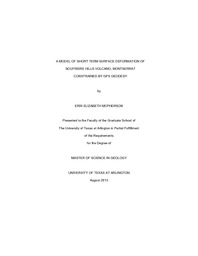| dc.description.abstract | Geodetic surveying is a core volcano monitoring technique. Measurements of how the crust deforms can give valuable insight into the mechanisms and processes that drive an eruption, and the way in which they change (Odbert et al., 2012). Campaign and continuous GPS geodetic measurements on Soufrière Hills Volcano, Montserrat are reported here from 1995 to 2010, spanning three dome growth and repose episodes extending the results of Mattioli et al. (2010). Soufriere Hills Volcano (SHV), Montserrat, in the Lesser Antilles island arc, became active in 1995, and for nearly two decades, geodetic surveys have been conducted using both continuous and campaign GPS observations. Data have been collected and processed using the latest and most advanced geodetic instruments and techniques available. The NSF-funded CALIPSO and SEA-CALIPSO projects have allowed for some of the most in depth studies of the ongoing SHV eruptions to date, and many models for surface deformation and magmatic chamber configuration have resulted (Voight el al., 2013). I focus on data gathered from the early stages of the SHV eruption in 1996 through the end of 2010 from two continuous GPS sites, Hermitage Peak (HERM , located &sim1.6 km from the vent) and Montserrat Volcano Observatory 1 (MVO1, located &sim7.6 km away from the vent). These data have been reprocessed using GIPSY-OASIS II (ver. 6.1.2) with final, precise IGS08 orbits, clocks, and earth orientation parameters using an absolute point positioning (APP) strategy. The study is being conducted to re-examine spatial and temporal changes in surface deformation, constrained by GPS, and to better illuminate the short term (i.e. sub-daily to weekly) deformation signals noted amongst the longer, cyclic deformation signals (i.e.monthly to annually) that have been previously reported and modeled. In addition, I have extended the time series for HERM and MVO1 to the end of 2010, beyond what has been previously analyzed and published by Mattioli et al. (2010). The reprocessed time-series show lower variance for daily APP solutions over the entire temporal data set; trends in the long-term inflation and deflation patterns are generally similar to those previously published (e.g. Elsworth et al., 2008; Mattioli et al., 2010; Odbert et al., 2012), but now superimposed, shorter term signals are more clearly visible. | en_US |


